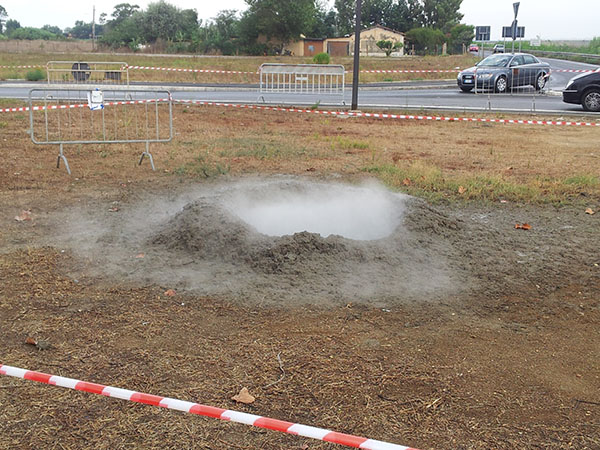
by Chris Samoray Monday, March 3, 2014

Gas leaks from the crater found near Rome's airport. Credit: Giancarlo Ciotoli.
On Aug. 24, 2013, visitors arriving at Rome’s Leonardo da Vinci International Airport, located in the Fiumicino municipality, flew over a surprising hazard: a gas emission that suddenly exploded from the ground a few meters outside the airport compound. The expulsion, referred to as the Fiumicino Gas Vent (FGV), occurred about 15 kilometers southwest of Rome and was first noticed by passing motorists. Shortly after the explosion, scientists sought to determine the gas’ makeup and whether it posed a continuing danger.
When researchers arrived at the site, they found a crater half a meter wide filled with cold water and bubbling gas. Using an infrared sensor, the team, led by Giancarlo Ciotoli of the Italian Institute for Environmental Protection and Research in Rome, analyzed the gas composition. Results showed that the gas was 95 percent carbon dioxide, with small amounts of nitrogen and methane and trace amounts of ethane and hydrogen sulfide.
At such high levels, carbon dioxide can have adverse health effects “for anyone who stops for a while in the immediate vicinity,” Ciotoli says, adding that some small dead animals were found near the site.Fortunately, he says, the vent formed far enough from houses so that people weren’t endangered by the eruption.
Based on the local geology, the scientists first assumed the carbon dioxide had been produced in shallow peat deposits. But infrared spectroscopy and gas chromatography results in the lab indicated that the gas was instead from the deep crust or mantle, resembling gases emanating in nearby volcanic districts. This could imply a more permanent gas reservoir, Ciotoli says.
“The leak of biological gas, which is stored in small subsoil pockets, generally lasts a short time, months [or] years. The existence of a deep geothermal gas implies a larger, pressurized and long-lasting source,” he says.
Ciotoli’s team surveyed the rest of Fiumicino for soil gas levels and found that similar gas vents occur in many areas throughout the municipality. Indeed, a month after the initial blowout, another vent formed just 2 meters away. Both have since been sealed by injecting concrete.
Ciotoli says that the mechanism by which the gas makes its way to the surface is unclear. But he and his colleagues suggest that an underlying regional fault system is responsible for the gas’ transport to the surface. Unlike some other faults in the region, the faults below the FGV extend deeper into the crust and thus can act as a pathway to the surface, the team reported in Geophysical Research Letters.
Citoli’s team did not examine why gas suddenly erupted exactly when and where it did at the FGV. But at least one other gas emission in the area similar to the FGV was caused by shallow drilling, says Massimo Ranaldi, a geologist at Roma Tre University in Rome who wasn’t involved in the research. That emission was produced by a gas blowout from a well that encountered an underground, pressurized gas pocket, Ranaldi says.
“Gas emissions of this kind are an important issue to study” to understand the hazard and assess the risk they pose, Ranaldi says, and to help develop techniques to avoid such accidents when drilling in risk-prone areas. It is also “scientifically interesting to understand the origin of carbon dioxide and the mechanism of its ascent toward the surface,” Ranaldi says.
© 2008-2021. All rights reserved. Any copying, redistribution or retransmission of any of the contents of this service without the expressed written permission of the American Geosciences Institute is expressly prohibited. Click here for all copyright requests.